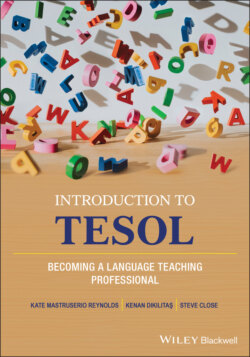Читать книгу Introduction to TESOL - Kate Reynolds - Страница 26
TESOL Is Highly Interdisciplinary
ОглавлениеThe discipline of TESOL draws upon other fields to inform their perspectives. For example, research from psychology provides important contributions on how children and adults grow, think, and learn, how first languages are acquired, and how the brain stores and processes information. From anthropology, we learn about culture, cultures, and cross-cultural interaction. From linguistics, we understand more about the structures, sounds, meanings, functions, and uses of language. The intersection of psychology and linguistics enhances understanding of the neurological processing of linguistic information in the brain. The field of foreign/world language teaching contributes insights into proficiency levels, traditional and interactive language methods, and assessment practices. From communications, we draw strategies of oral communication in formal talks and presentations as well as studies in cross-cultural and intercultural communications. English composition studies provide insights into the learning and teaching of writing to native speakers, writing genres and structures, patterns of written discourse, sentence-level written grammar, and argumentation. The various fields of teacher education, such as literacy, curriculum and instruction, educational diversity studies, and instructional assessment, offer insights into the instruction and assessment of reading by native speakers, curriculum development, academic content learning, lesson planning, lesson delivery, assessment design and interpretation, educational institutions, and culturally responsive instruction.
The TESOL specialist combines knowledge from all of these areas with second language acquisition theory (how people acquire/learn additional languages as well as the personal, sociocultural, and linguistic influences on the processes). The TESOL specialist applies this information to appropriate instructional planning, delivery, and assessment for ELLs at all ages from nursery school to university.
The discipline also interacts with academic content areas (i.e., subjects of literature, math, science, and social studies/history) as well as subjects considered “special topics” in the schools (i.e., music, art, and physical education). When TESOL specialists combine academic fields, this is called content-based ESL instruction (CBI) or sheltered content instruction, while in the European context this content and language integration is referred to as content and language integrated learning (CLIL), which is discussed in Part Two. CLIL holds both content and language as dual instructional goals integrating them equally to support simultaneous development of both knowledge bases.
Vocational content areas are studied by ELLs for professional purposes, such as aviation, law, business, engineering, design, tourism studies, etc. This intersection of vocational content and language study is English for specific purposes (ESP). You will find ESP courses listed as Business English or Legal English in adult education or university language programs.
